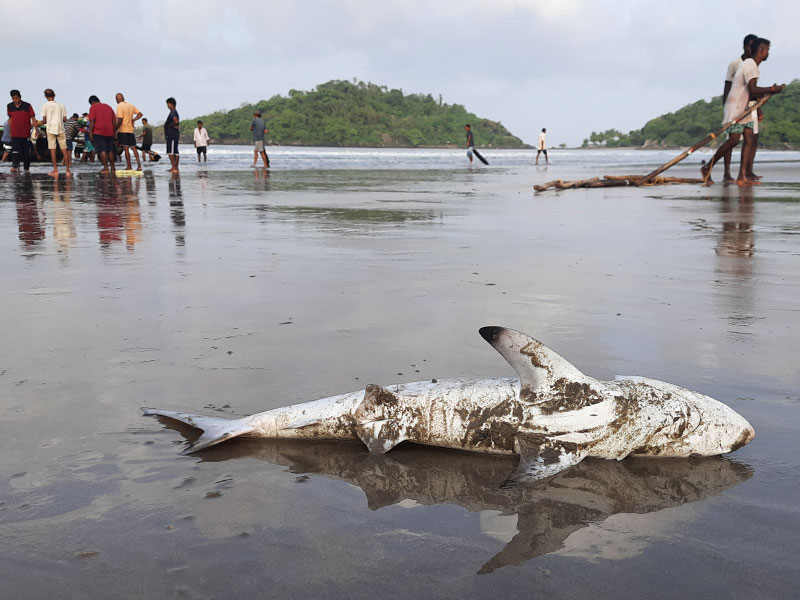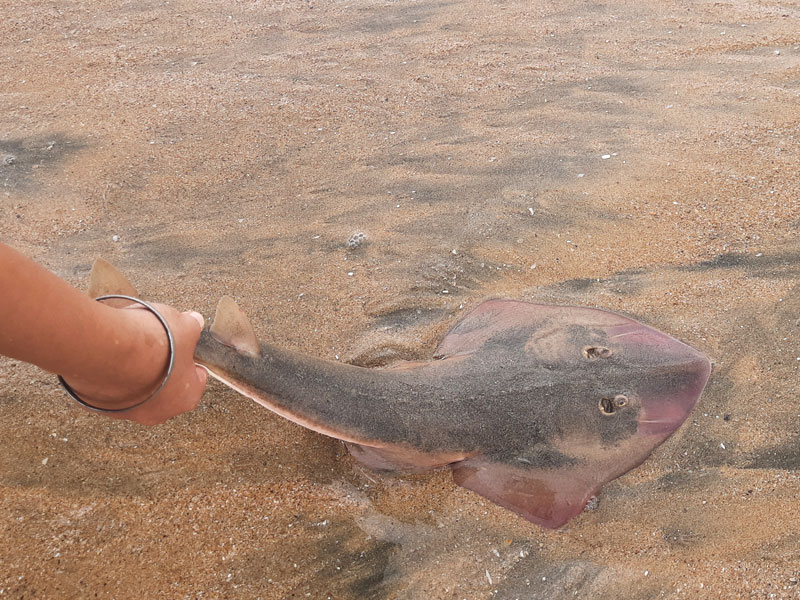With support from the Levine Family Foundation, doctoral researcher Trisha Gupta is taking action to protect some of India’s most enigmatic and misunderstood marine species.
Sharks are older than the dinosaurs and yet their populations – and those of their close relatives, rays – are in rapid decline around the world. The impact of harmful fishing activity, coupled with the pressures of climate change and their slow growth and low birth rates, are pushing some species to the brink of extinction. In the last half-century alone, the global abundance of oceanic sharks and rays has fallen by 71%.

Marine conservationist Trisha Gupta first became interested in these species groups while interning on a project about bycatch – the incidental capture of non-target species – in India. She had been doing some fieldwork on the west coast when she came across a local fisherman selling a hammerhead shark on the beach. It was a pregnant female – a fact easily ascertained by its injuries. ‘I could see the tail fins of the unborn sharks...’ she recalls.
It was an affecting moment and Trisha realised that, despite having a degree in marine biology, she knew very little about these captivating animals. ‘I dived into the research and discovered that a) sharks are highly threatened and b) they’re worth a lot of money. That one hammerhead shark was sold for £140 or £150, which is a huge amount for a fisherman in a small village in India,’ she says.
Fast forward to the present day and Trisha is now coming towards the end of a four-year DPhil project in the Department of Biology, which has seen her exploring the sustainable fishing of sharks and rays in India.
For decades India has been one of the world’s top shark and ray harvesting nations. While occasionally targeted by some fishing communities, sharks and rays (collectively known as elasmobranchs) are predominantly caught as bycatch before being sold on commercially. A big focus of Trisha’s work has been aligning the conservation of India’s sharks and rays with the needs of local communities, for whom these species can be key contributors to both livelihoods and food security.
A significant challenge to this aspiration has been the enormous evidence gap that exists around the ecology of elasmobranchs in India. ‘The marine space is very overlooked compared to terrestrial spaces,’ Trisha explains. ‘It is only in the last decade that people across the country have started to pay attention to elasmobranchs. Before that they were just thought of as another resource: How do we exploit them? How do we maximise our gains from them? They were never thought of as endangered and potentially at that point they weren’t, but we’ve gone well beyond that now.’
In India we have tigers, we have rhinos, we have elephants, and that tends to draw a lot more attention compared to anything in our oceansTrisha Gupta
Trisha’s research has focused predominantly on the small-scale fisheries that operate across her two study sites: Goa, on the west coast of India, and Kakinada, which sits on the east coast. In Goa, the growth of tourism over recent years has posed a threat to marine species but also offered alternative livelihoods for fishers and incentives for conservation. Fishing communities in Kakinada, on the other hand, are among the poorest in India and entirely reliant on their catch to get by.
In both locations, she has had to work hard to build trust. ‘I’m lucky that everyone I’ve met so far has been really friendly, but it takes time,’ she says. She relocated to Goa for three months last year in the run up to a key part of her project, which involved asking sensitive questions about measures that could reduce or stop elasmobranch fishing entirely. ‘My research assistant and I would go out to the beach every day and interact with the people there – we became part of that space.’
During the course of her work, Trisha has identified several key species in need of targeted conservation measures, including the widenose guitarfish – a small ray that spends most of its time concealed on the sea floor. ‘I absolutely love them,’ she says. ‘They have a very low economic value in Goa but they’re highly, highly threatened.’ Trisha has been conducting research to understand the habitat use and post-capture survival rate of the guitarfish, and then working with fishers to release them back into the water once they’ve been caught accidentally.

As well as devising measures to reduce bycatch, Trisha has been involved in a collaborative project investigating the increase in elasmobranch meat consumption in restaurants in Goa. Sharks and rays have long been consumed by tribal and coastal communities in India, but in recent years have also found favour among foreign tourists, particularly those from Russia and the UK. The restaurant owners who were interviewed for the project said their customers were attracted to the lack of bones in the meat, and to the idea of trying something a ‘bit different’.
Trisha is now joining forces with local conservationists who plan to launch a campaign against shark meat consumption. The aim is to encourage chefs and tourists to choose other, more sustainable fish. ‘It’s very much in the preliminary stages but I do feel some amount of hope. It’s a relatively new form of consumption and I think we can make sure it doesn’t grow or even reduce it. That would make a real difference to the kind of pressure these species are facing,’ she says.
Trisha’s research has been buoyed by her integration in Oxford’s Interdisciplinary Centre for Conservation Science, an academic research group that addresses the challenges humanity faces in halting the decline of biodiversity. ‘It’s a very diverse group,’ she says, ‘especially the DPhil students. A lot of us are biologists or natural scientists but we also have people with economics, policy and psychology backgrounds… it’s just been an incredible learning experience.’
It is an experience that she says would not have been possible were it not for the support of the Levine Family Foundation, which is funding her research. Annual course fees for international students undertaking a doctorate at Oxford are currently in excess of £30,000. ‘Just to give you an idea,’ says Trisha, ‘when I was working at an NGO in India I would make £300 per month. I would have had to save for 100 years to be able to afford to come here.’
I am very, very lucky and grateful to get the funding. Not only did the foundation support my PhD but they also gave enough to support my fieldwork, and they’ve been so kind. They are genuinely interested in seeing me succeedTrisha Gupta
With her DPhil coming to a close, Trisha is now focusing on her next steps. She has recently secured a job as a conservation scientist on the Zoological Society of London’s EDGE of Existence programme, a role she will take up full time once she has defended her thesis later this year. And there is hope that some of the work she started while at Oxford will also live on – one of her research assistants has been writing grant applications to enable something longer term to be set up. ‘That just makes me very happy,’ says Trisha, who plans to remain involved in a supervisory capacity.
When reflecting on her own work, Trisha is extremely modest. ‘I think sometimes what I find challenging is that whatever impact I have is on a small scale. It’s just a small part of India and within that we’re working with just a few communities.’ Isn’t that so often how big change comes about though? ‘I hope so,’ she says. ‘I do think that positive action leads to further positive action and sets things off in other places as well. That is very much what I’m hoping for.’